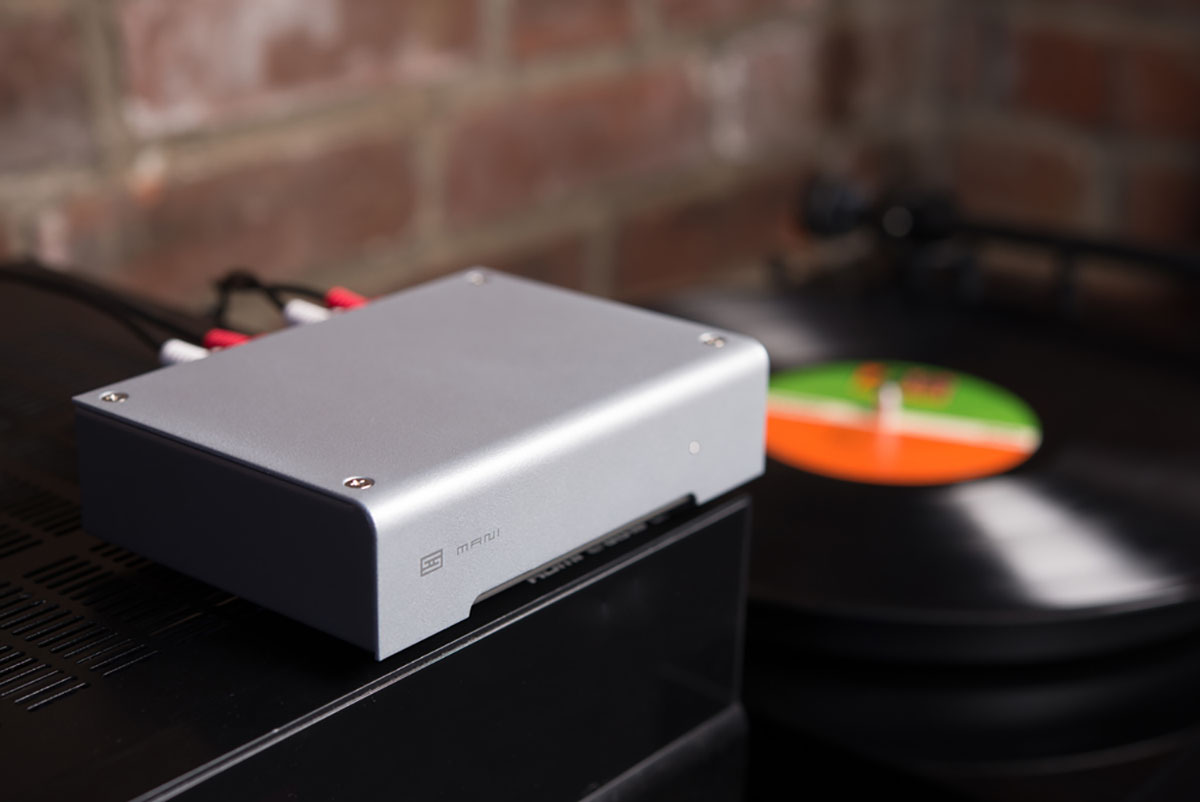
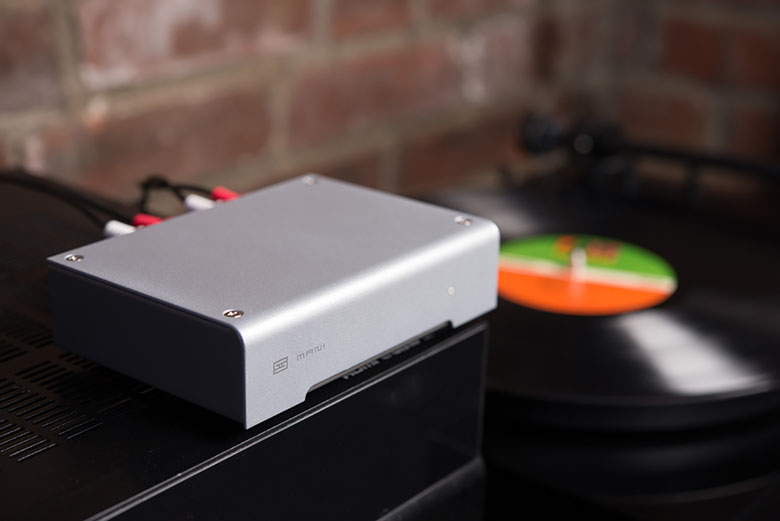
Great vinyl playback isn't always easy to get right. Record players are very much like fine musical instruments, and to get them sounding at their best, your vinyl rig really needs an audiophile-grade phono stage preamp. To disperse the mystery surrounding these highly-specialized pieces of audio gear, we decided to pick the top current examples on the market and go in-depth into what makes a great phono stage, along with what to look for when buying one (in our buying advice section below our picks). Phono stages can be tricky, but they’re also essential. And to complete your system, see our article on the best turntables.
 MM / MC: Both
MM / MC: Both
Cartridge Capacitance Range: 100pF.
Input Gain Range: Variable (39 and 60dB)
Impedance Range: 100Ω - 47KΩ
What We Like: Great looks, terrific dynamics - and a built-in headphone amp.
What We Don't: The sound quality is warm and rich, but sometimes lacks energy.
We genuinely can’t think of a preamp that offers this much for under $500. It’s not just the fact that the Cambridge Audio Alva Duo sounds great, with excellent dynamic range. It’s also the clever features that you won’t find on other phono preamps. These include a headphone amp, which is almost unheard of on phono stages (certainly, no other model here can deliver it). The Alva Duo offers support for both MM and MC cartridges, which makes integrating it a cinch. And we appreciate the small touches, like the fact that the labels for the connections on the rear are written both right way up and upside down, so you can read them while leaning over the back (that’s genuinely clever). Impressively, the Alva Duo packs in all these features in while looking sleek and modern.
While the Cambridge Audio Alva Duo offers excellent dynamics and stereo spread, we did find that the sound quality lacked a little punch. It didn’t give us the visceral connection that other similarly priced preamps offer. As an example, the $399 Pro-Ject Tube Box S2 MM/MC sounded much more energetic, and even the Schiit Mani 2 has a little more drive and oomph. However, in terms of combining (mostly) good sound with excellent features and a competitive price tag, we think the Alva Duo is a winner.
See the Cambridge Audio Alva Duo
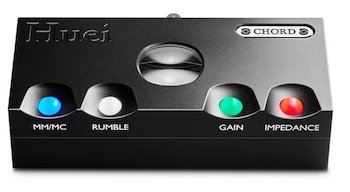 MM / MC: Both
MM / MC: Both
Cartridge Capacitance Range: 50 - 150pF.
Input Gain Range: Variable (60, 65 and 70dB)
Impedance Range: 30Ω - 47KΩ
What We Like: Simple and effective design matched with excellent audio quality and handy features.
What We Don't: Fewer capacitance-switching options than other similarly-priced preamps.
For a preamp that balances superb sound quality, clean and eye-catching design, and useful features, we heartily recommend the Chord Electronics Huei. The overall sound quality of this phono stage is the true killer feature: wide, ballsy, clear, and arguably better than just about any other preamp on this list (short of monsters like the $2,500 PS Audio Stellar, below). Moreover, the design contributes to it being our top pick. High-end preamps tend to be complicated, but the Huei couldn’t be simpler. It’s as close to plug-and-play as you can get, and great features— like a handy rumble switch to tame any artifacts—make it a joy to use. One listen, and it’s clear that this is the phono preamp to buy if you’re investing in your system.
What are the shortcomings of the Chord Electronics Huei? We would have liked to see a little more in terms of capacitance-switching options. Cheaper options like the Dynavector P75 Mk4 ($895) offer a much wider range, for example, and it’s puzzling not to see this in a genuine high-end model like the Huei. That means that this preamp may not be ideal for those using MC cartridges with their turntables, and if you do have an MC cartridge, make sure that it fits into the Huei’s range before buying. Despite this slightly odd omission, the Huei is a remarkable phono preamp and unquestionably will improve the sound of your system and make it a genuine pleasure to operate.
See the Chord Electronics Huei
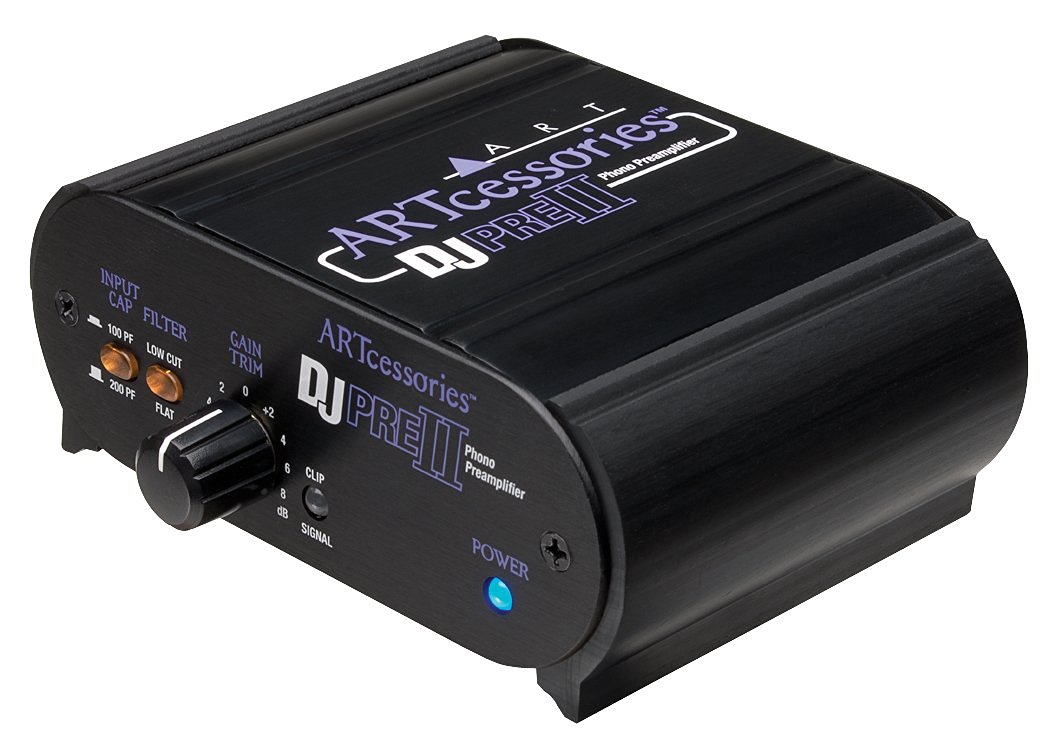 MM / MC: MM
MM / MC: MM
Cartridge Capacitance Range: 100pF and 200pF (switchable)
Input Gain Range: 45dB
Impedance Range: 47KΩ
What We Like: Well-designed and good sound for the money.
What We Don't: The stereo imaging is a bit unbalanced.
Budget preamps are relatively easy to come by, but it’s tough to find one with the pedigree of the ART DJPREII. Since its debut eight years ago, it’s sold in the bunches and remains one of the most reliable, effective, and simple preamps around. The sound is excellent, and the features compare favorably to pricier units. There’s a rumble filter, just like our top pick, the Chord Electronics Huei, and you also get switchable capacitance and variable gain, all of which work well. It takes a little time to dial in the DJPREII—especially with the gain knob potentially sending signals into the clipping zone—but once set, the DJPREII is worth every penny.
What are the downsides of the ART FJPREII? The sound is respectable but can suffer with challenging material. If you listen to genres like orchestral music, or anything with busy instrumentation, you’re going to notice some problems in the stereo image. And while this amp has stood the test of time, the looks could definitely could use an update. Regardless, the DJPREII is a proven winner at this price point. We’d always rather steer you in the direction of a tried and tested preamp, and this model certainly fits the bill.
See the ART DJPREII
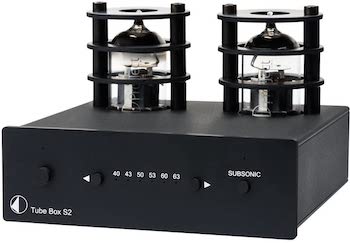 MM / MC: Both
MM / MC: Both
Cartridge Capacitance Range: 47-587pF
Input Gain Range: 40-63dB
Impedance Range: 10Ω - 2KΩ
What We Like: One of the few tube preamps under $500 - and it sounds terrific.
What We Don't: Tube rolling is very tricky.
Most preamps are solid-state—as in, they rely on discrete electrical circuitry to get the job done—but that’s not the case with for the Pro-Ject Tube Box S2 MM/MC. It uses vacuum tubes to amplify the signal, and in contrast to the clean, sometimes sterile sound of electronics, tubes provide a much warmer, fudgier impression. It’s very rare to get a tube preamp for under $500, and we were delighted when Pro-Ject released this model. It doesn’t have the feature set or design to compete with other similarly priced preamps, like the sleek Cambridge Audio Alva Duo. But it offers a different—and welcome—audio experience. If you like your vinyl sound to be warm and full and aren’t interested in pinpoint accuracy, this is a great preamp.
One thing you won’t be able to do with the Tube Box S2 MM/MC is swap out the tubes (not without some difficulty, at least). The design, with cages around the tubes, makes it tough to do so, which means that the Tube Box S2 MM/MC isn’t the best option if you want to adjust the sound. And if you want to stick with Pro-Ject but don’t want to mess around with tubes, the company offers an excellent solid-state alternative, the Phono Box S2 Ultra below, for around a hundred dollars less.
See the Pro-Ject Tube Box S2 MM/MC
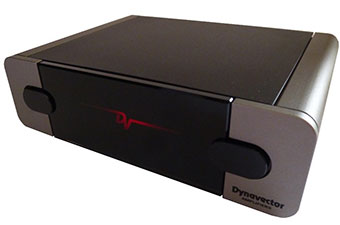 MM / MC: Both
MM / MC: Both
Cartridge Capacitance Range: 100/200/300pF (Selectable)
Input Gain Range: 40 - 66dB (Selectable)
Impedance Range: 30Ω - 47KΩ (Selectable)
What We Like: Adjustable, plenty of features.
What We Don't: 12V DC Power Supply is not included.
Dynavector Amplifiers from Australia promise that their P75 Mk4 offers 'a far superior rejection of common-mode noise' than any other phono amplifier. Despite sounding like a bold statement, especially in the company of the high-class phono stages on this list, we like strong convictions. The P75 Mk4 is a fabulously spec'd device, which is extremely quiet and versatile. This phono stage can be matched to virtually any cartridge on the market - done easily by several user-definable internal jumper blocks settings. These internal mini-switches can be adjusted to suit low, medium, and high output cart signals with a wide selection of impedance and capacitance options.
One of the features that make the Dynavector somewhat unique is their patented 'Phono Enhancer' option, which is particularly useful for low-output Moving Coil cartridges. To avoid using heavy technical jargon, we describe this function as a 'fine-tuning' of the impedance loading. This is easily done, even if you are new to this sort of thing - just follow the manual's recommended setting for your specific cartridge. The sonic performance is close to spectacular, even when compared to the majority of devices in this price range. However, there is one major aspect missing - slightly mind-boggling even. The P75 Mk4 does not come with a power supply. Yes, it is only a regular 12DC 500mA current required to power the unit, but we strongly believe that a matched PSU should be included - especially for the price! This oversight definitely knocks the P75 Mk 4 down a couple notches, in our opinion.
See the Dynavector P75 Mk4
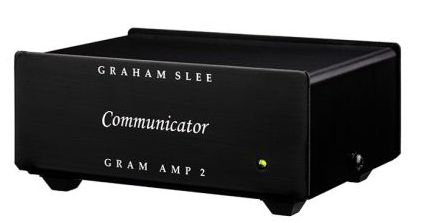 MM / MC: MM
MM / MC: MM
Cartridge Capacitance Range: 220pF
Input Gain Range: Unavailable
Impedance Range: 47KΩ
What We Like: We loved the ridiculous timing and detail on this preamp
What We Don't: There are issues in the mids - the audio of vocals and acoustic guitars can be quite floaty.
If you’re an audiophile, you probably let out a slight whimper upon seeing the name Graham Slee. The man has fans. And while we don’t consider ourselves die-hards, there’s no denying that he makes a very fine preamp. The Gram Amp 2 Communicator is one of his best, and the surprisingly basic design and feature set hide outstanding sound quality. It’s the timing and detail that’ll get you, and the Communicator really does put recordings in the best possible light. In a way, it’s the polar opposite to something like the tube-based Pro-Ject Tube Box S2 MM/MC, providing a balanced and realistic sound versus the gooey tube output of the Pro-Ject pre.
Most of the time, anyway. We did find that with elements like vocals and acoustic guitars, the Gram Amp 2 Communicator lost the plot a little. When these took center stage, the sound became floaty and unrealistic. We like the Gram Amp 2 Communicator and it’s a worthy alternative to the other preamps on this list, but it’s not quite perfect.
See the Graham Slee Gram Amp 2 Communicator
 MM / MC: Both
MM / MC: Both
Cartridge Capacitance Range: 100-467pF
Input Gain Range: 5-12dB
Impedance Range: 33Ω - 47KΩ
What We Like: Wonderful sound quality for the price.
What We Don't: Super-fiddly back panel.
Hegel are known for their elegant components, and the V10 is no exception. It’s initial impression is of smooth, clean, engaging sound, with good detail in the bass and a wide and present soundstage. We’d actually rank it above more expensive models like the PS Audio Stellar, as we think it does a better job with challenging material. It’s particularly good at Moving Coil cartridges, as it uses four ultra-low-noise discrete JFET transistors on the input stage. This eliminates any unnecessary noise, and makes it the obvious choice if you prefer this cartridge type.
But here’s the really odd thing about the Hegel V10, and the reason it isn’t placed higher. From the front, the design is elegant and assured. But from the back…Lord. You control gain, load resistance, capacitance and filters via a set of very tiny dip switches that are wedged underneath the inputs and outputs, and are a gigantic pain to operate. It’s a surprisingly cluttered and fussy control system, and we’ll be honest: it doesn’t work. We would happily have sacrificed the elegance on the front end for a few sensible controls. Bottom line: the V10 sounds terrific, but can be difficult to use.
See the Hegel V10
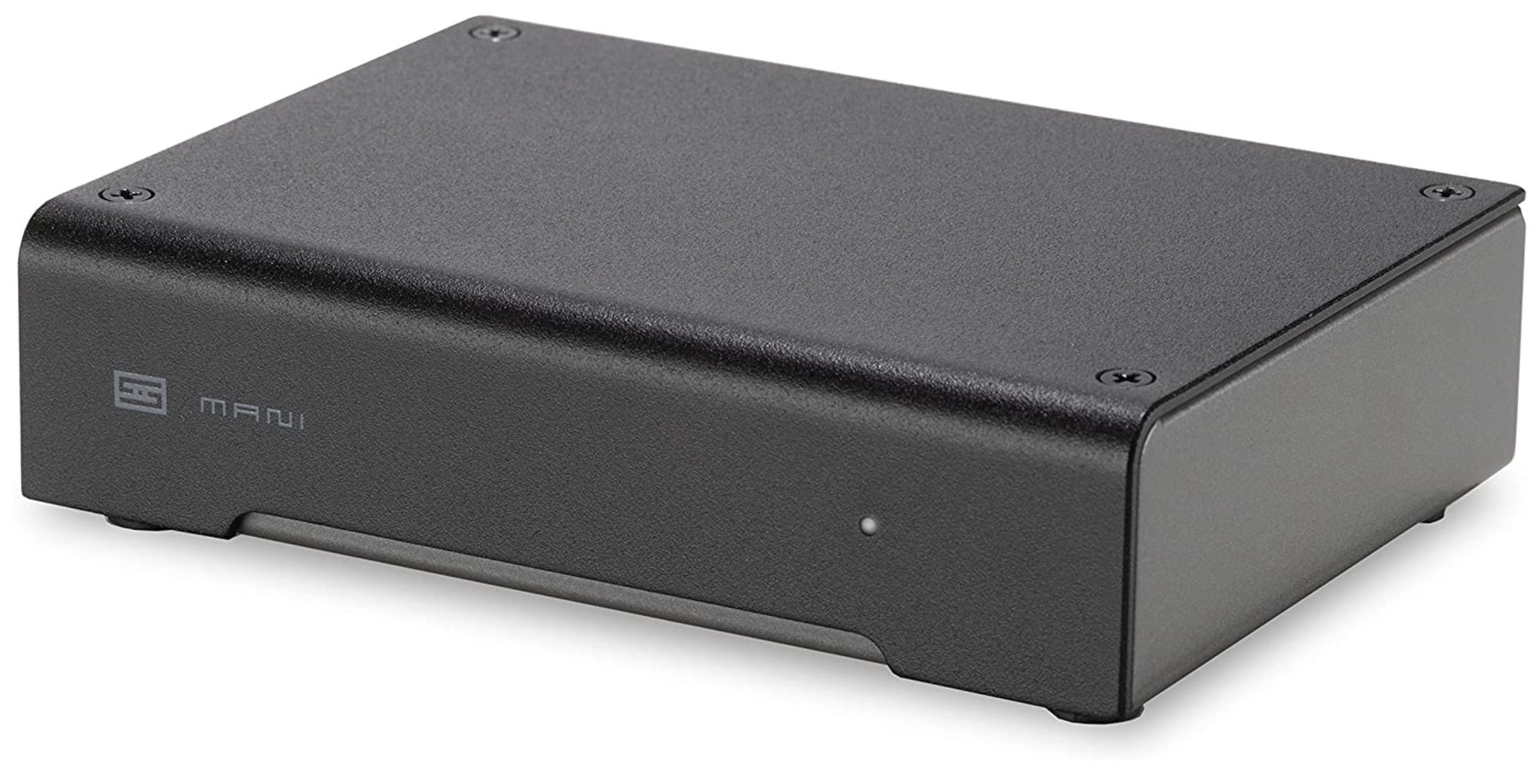 MM / MC: Both
MM / MC: Both
Cartridge Capacitance Range: N/A
Input Gain Range: 4 switchable gain modes (30, 42, 47, and 59dB)
Impedance Range: 47Ω (MC) / 47KΩ (MM)
What We Like: Famed Schiit build quality and sonic performance.
What We Don't: There are better, cheaper options.
Schiit’s reputation is second to none - we’ve reviewed many of their highly desirable audio toys, from headphone amps to DACs, and if you’re unfamiliar with their line of products (all made in the U.S.) just check their current catalog. The Mani 2 is their take on a specialized phono preamp, and it is equally at home with classic moving coils or with high output magnets as far as cartridge signals go. We adore the simple design, with its clean lines - it's minimalist, but unlike the far more expensive Pro-Ject Phono Box S2 Ultra, it looks good.
The input impedance that Mani 2 can take is automatically adjusted from 47 Ohm (typical for MC carts) to 47 kOhms (MM carts) and the Mani 2 also allows four user definable input gain settings for boosting those ultra-low moving coil signals. Just like many phono stages, Schiit have deployed the RIAA classic curve tonality and all that of course is achieved with passive equalization. High voltage PSU keeps mains pollution noise at bay, and the sonic precision of this preamp belies its fairly modest price. It's not the first choice for a budget phono stage - that would be the ART DJPREII - but it's an excellent preamp.
See the Schiit Mani 2
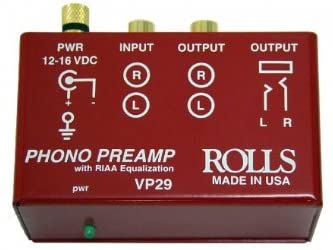 MM / MC: Both
MM / MC: Both
Cartridge Capacitance Range: 120pF
Input Gain Range: 42dB
Impedance Range: 1KΩ - 47KΩ
What We Like: Excellent performance and clean design.
What We Don't: The soundstage can get wonky at high volumes.
Sometimes you just need a phono preamp that gets the job done, with zero fluff. If that’s the case, then we strongly recommend the Rolls VP29. It’s as basic a preamp as you can get: a simple plug-and-play box with virtually no features to speak of. But the basic design doesn’t necessarily equate to compromised performance. Quite the opposite, in fact: the sound quality is energetic and clean, able to make sense of even the busiest records. Essentially, it offers a cheap and effective way to add a phono preamp to your system, and the value here is off the charts.
There are some problems with the Rolls VP29, though. Turn the volume up, and the soundstage can start to get a bit wobbly. That’s worth bearing in mind if you like listening loud, and if that’s the case, the ART or the Pyle Pro Pp999 may be better options. And here’s a bit of buying advice worth noting: Music Hall, who also make preamps, literally started selling this model under their own branding, with new external housing over the exact same components, at almost double the price. They even neglected to remove the Rolls internal labeling, as this enterprising YouTuber discovered. That should tell you something about just how good this preamp is for the price.
See the Rolls VP29
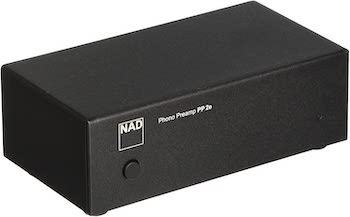 MM / MC: Both
MM / MC: Both
Cartridge Capacitance Range: 180-200pF
Input Gain Range: 35-60dB
Impedance Range: 100Ω - 47KΩ
What We Like: Smooth and engaging sound with solid build quality.
What We Don't: Lacking in advanced features.
In terms of sound quality, the NAD PP 2e is butter smooth. You get gorgeous, rich tones that aren’t overcooked, along with excellent transient speed. It’s clean, balanced, but never sterile. In this department, the NAD PP 2e is a step-up from budget amps like the ART DJPREII and Schiit Mani 2, and while spending a little more money will get you even better sound quality (just check out the Cambridge preamp above), the PP 2e is a superb mid-range amp. At under $200, it’s a steal.
The NAD PP 2e, however, is very light on features—you only get the ability to switch between MM and MC cartridges. It’s not a dealbreaker given that gorgeous sound, but you may want to look elsewhere if you want a more fully featured preamp. On that note, one option to consider is the newer NAD PP4, which does offer additional features including USB input and a full DAC section. But we think it’s a little overpriced at $229, and there are better options on this list. The Schiit Mani 2, for example, offers four switchable gain modes for less.
See the NAD PP 2e
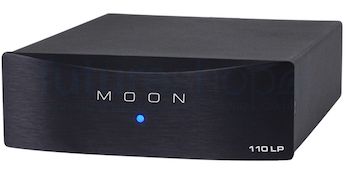 MM / MC: Both
MM / MC: Both
Cartridge Capacitance Range: 100-430pF
Input Gain Range: 40-66dB
Impedance Range: 10Ω - 47KΩ
What We Like: Lovely build matched with equally lovely sound.
What We Don't: Performance with MC cartridges leaves something to be desired.
We think the MOON by Simaudio 110LP V2 is one of the best phono preamps you can buy in the sub-$500 range, happily giving models like the Cambridge Audio Alva Duo a run for their money. The build is clean and assured, as is the sound quality. It’s genuinely good, rich and refined, with good spacing. There’s a good range of gain adjustments, and although you have to make these via those infernal dip switches (like the far more expensive Hegel V10), it’s not a dealbreaker at this price point.
One glaring downside to the MOON by Simaudio 110LP V2 was how it handled moving coil cartridge performance. It came off as a little mushy and undefined, and we’d say there are definitely better options if you prefer this cartridge type. The aforementioned Alva Duo, for one thing, which gives a more even performance. For moving magnet cartridges, however, and for those who need more attention paid to elements like game adjustments, the 110LP V2 is a good option.
See the MOON by Simaudio 110LP V2
 MM / MC: Both
MM / MC: Both
Cartridge Capacitance Range: Unavailable
Input Gain Range: 42-66dB
Impedance Range: 1KΩ - 47KΩ
What We Like: Great connectivity options, stellar sound quality, and a handy front screen.
What We Don't: ELAC doesn’t provide cartridge capacitance specs.
The ELAC Alchemy PPA-2 offers something you won’t find on virtually every other phono preamp: a digital display. You don’t know how handy this is until you actually have it. It’s an easy and effective way of accessing features, and crucially, switching between the many different connectivity options the PPA-2 gives you. This preamp is a collaboration between ELAC and component-maker Audio Alchemy, and both companies have clearly brought their A-game.
The PPA-2 matches its great feature set with lush, balanced sound. While we think the top-ranked Chord Electronics Huei sounds slightly better, the PPA-2 is a worthy competitor. It does have one slightly strange quirk, which is a lack of cartridge capacitance range specs. That’s not a dealbreaker, but it does make matching it with a specific cartridge somewhat trickier. It’s especially weird when you consider that even the least expensive preamps on this list manage to produce this fairly crucial spec (Exhibit A: the $69 Rolls VP29, with a listing of 120pF). Despite this issue, the PPA-2 makes for an interesting premium alternative to preamps like the Huei.
See the ELAC Alchemy PPA-2
 MM / MC: Both
MM / MC: Both
Cartridge Capacitance Range: 100 pF.
Input Gain Range: Fixed or Variable (44-72dB)
Impedance Range: 1Ω - 47KΩ
What We Like: Great audio quality, control for impedance settings.
What We Don't: Limited control for capacitance load settings.
PS Audio’s history reads like a film script. Paul and Stan were two guys just living in LA, who started an audio component company out of love for great sounding vinyl. Over 45 years later, their products are loved by audiophiles world-wide, and their newly released phono stage, the Stellar, claims to be their best ever. The Stellar’s designer, Darren Myers, broke away from the current norm of using integrated circuits and tweaked every component until they were perfect. The search for that elusive ‘drums in your room’ sound paid off in the end. According to PS Audio, this was the result of the special choice of FET semiconductors combined with a discrete circuit featuring the lowest possible negative feedback readings.
The Stellar boasts an extremely open soundstage, while also portraying a quick transient attack. This is especially noticeable when used with Moving Coil cartridges, which are traditionally much harder to amplify than Moving Magnet designs. Both MC and MM options are supported, allowing for two turntables or tonearms to be connected at once, alternating between MM and MC. The Stellar offers a wide range of impedance load and signal gain options, and it’s probably a first for us to see these switchable by a remote control. We are especially impressed by the custom load option, allowing you to sweep the MC input impedance between 1-1000Ω. The only thing we felt was missing was a more extensive control over capacitance load. The capacitance is fixed at 100 pF and, although this is fine for the majority of cartridges on the market, it’s less versatile than other preamps on this list. Besides this small criticism, the Stellar is a truly impressive phono stage that offers incredible value.
See the PS Audio Stellar
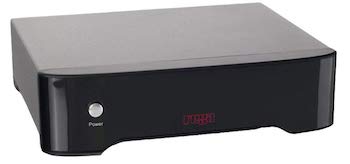 MM / MC: MM
MM / MC: MM
Cartridge Capacitance Range: 100pF
Input Gain Range: 41.4dB
Impedance Range: 47KΩ
What We Like: Stylish simplicity, great sound.
What We Don't: There are limited loading options.
Rega have taken the interesting approach of splitting their Rega Fono MkIII phono preamp into two products. One is dedicated purely to Moving Coil phono cartridges and the second, the Fono MM, is for Moving Magnets only. Because of this fact, the Fono MM is stripped of the multitude of switching options and functions found in other phono stages on this list. Despite this, Rega have made sure that the circuit design is one-size-fits-all, and as long as you’re using an MM cartridge, the Fono MM will be fine. That’s quite an understatement, actually, as Rega have been collecting industry awards with it virtually every year since its release.
So, what’s special about this phono stage besides its sleek exterior? Rega have given special attention to the input stage, using a fully discrete, cascaded, complementary design. This, combined with the polyester caps used in the circuit, provide a classic design platform for MM cartridge loads. Further efforts and a special choice of polypropylene capacitors have been reserved for the passive RIAA equalization circuit. We explain the importance of passive equalization in our Buyer’s Guide, below, but it suffices to say that the frequency response of this phono stage delivers a very sweet and classy character. The transient delivery is immediate and punchy, with plenty of weight in the attack. In our opinion, records are virtually transformed through this rig. If you want a serious phono stage, without breaking the bank, the Rega Fono MM MkIII is worth looking at.
See the Rega Fono MM MkIII
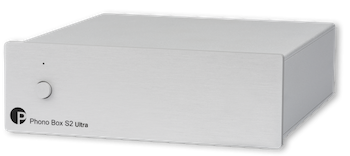 MM / MC: Both
MM / MC: Both
Cartridge Capacitance Range: 100 - 420pF
Input Gain Range: 40 - 63dB
Impedance Range: Variable 10Ω - 47KΩ
What We Like: Audiophile components with killer specs and sound.
What We Don't: The preamp has pretty dull design.
Replacing the ever popular Phono Box DS and DS+, the newly released Pro-Ject S2 Ultra is very closely related the limited edition Phono Box Ultra 500. Amazingly, that came about as a token of appreciation to Pro-Ject customers, after reported sales of 500,000 Phono Box units. Just like their line of turntables, Pro-Ject’s catalog of phono preamps continues to grow. If you’ve felt slightly overwhelmed by the number of phono stage choices on their website you won’t be the only one. In simple terms, the S-line of products offers a great value for money and the new S2 Ultra bridges the gap between affordable and audiophile. What’s unique about the Ultra, and especially at this price point, is its op-amp-less design. Operational Amplifiers, also known as op-amps, are circuit components widely used to boost the whisper-quiet cartridge signals. These type of circuits have a specific sound and this is what Pro-Ject have decided to shift away from.
Employing a fully discrete layout, no doubt borrowed from their more expensive models, Pro-Ject seem to have achieved something altogether classier-sounding. The use of polystyrene capacitors, for instance, is a contributing factor to the silky highs, and the response from listeners has been amazing already. The S2 Ultra is incredibly closely attuned to the famed RIAA frequency curve and just like with the Violectric at number 8, it features a multitude of dip switches for adjustment of signal impedance, capacitance, and gain. Pro-Ject seem very proud of the S2 Ultra’s ‘incredibly harmonious sound’ and we agree they have a point.
See the Pro-Ject Phono Box S2 Ultra
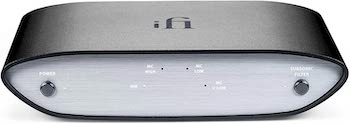 MM / MC: Both
MM / MC: Both
Cartridge Capacitance Range: Unavailable
Input Gain Range: 36/48/60/72dB
Impedance Range: 47KΩ
What We Like: Full-bodied and warm sound quality matched with eye-catching design.
What We Don't: Fixed MM/MC loads may be problematic.
The folks at iFi Audio have completely redesigned their product lines lately, and the new Zen Phono is certainly eye-catching, with a simple design and full-bodied, warm sound. While, on balance, we prefer the Schiit Mani 2, which we think has a touch more life and energy to it at a lower price, there’s no denying that the quality of the audio from the Zen Phono is excellent. There’s even a filter available to deal with slightly warped records.
You get a good range of settings on the Zen Phono depending on whether you use MM or MC cartridges, however this does highlight the preamp’s one big weak spot. It has fixed loads depending on the gain, and if you run a low output cartridge such as one from Ortofon, you may not get the results you want. That, plus the fact that there are a huge number of excellent competitors at this price point, mean that the Zen Phono is a good, but not spectacular phono preamp.
See the iFi Audio Zen Phono
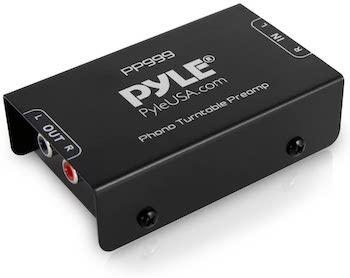 MM / MC: MM
MM / MC: MM
Cartridge Capacitance Range: Unavailable
Input Gain Range: Unavailable
Impedance Range: 10KΩ
What We Like: The sound has a surprising amount of punch for the price.
What We Don't: Subpar build quality and fugly looks.
There are some real gems in the budget preamp category, and we think the Pyle Pro Pp999 is one of them—it’s certainly one of very few preamps under about $50 that we’d recommend. The sound is light years ahead of the price: weighty and effective with some real punch. While the slightly more expensive Rolls VP29 has a more assured and confident sound, the Pp999 manages to hold its own. It’s quite basic with almost no features, as you’d expect at this price range, but we certainly don’t hold that against it. If you want a solid budget preamp, then the Pyle Pro Pp999 is well worth considering.
Be warned though. While the Pp999 probably won’t break on you, the build quality is unlikely to survive a knock or a drop. And while we appreciate the basic, clearly labelled input and output sections, this is not a preamp that you are going to want to show off to your friends. It is, to use the technical term, fugly. But it’s very hard to get mad at a preamp that offers so much for so little. For the price, it can make your recordings sizzle like butter in a hot pan, and is a great and surprisingly cheap addition to your system.
See the Pyle Pro Pp999
| Preamp | Price | MM/MC | CCR* | IGR** | IR*** | A/B*** |
|---|---|---|---|---|---|---|
| Cambridge Alva Duo | $349 | Both | 100pF | 39/60dB | 100Ω-47KΩ | Unavailable |
| Chord Huei | $1,495 | Both | 50-150pF | 60/65/70dB | 30Ω-47KΩ | Unavailable |
| ART DJPREII | $65 | MM | 100pF / 200pF | 45dB | 47KΩ | Solid State |
| Pro-Ject Tube Box S2 | $399 | Both | 47-587pF | 40-63dB | 10Ω-2KΩ | Unavailable |
| Dynavector P75 Mk4 | $895 | Both | 100-430pF | 40 - 66dB | 30Ω-47KΩ | Unavailable |
| GS Gram Amp 2 | $379 | MM | 220pF | Unavailable | 47KΩ | Unavailable |
| Hegel V10 | $1,500 | Both | 100-467pF | 5-12dB | 33Ω - 47KΩ | Unavailable |
| Schiit Mani 2 | $188 | Both | 100pF | Various | 47Ω - 4KKΩ | ADA4897/AD8066 |
| Rolls VP29 | $59 | Both | 120pF | 42dB | 1KΩ-47kΩ | Unavailable |
| NAD PP 2e | $219 | Both | 180-200pF | 35-60dB | 100Ω-47KΩ | Unavailable |
| MOON 110LP V2 | $600 | Both | 100-430pF | 40-66dB | 10Ω-47kΩ | Unavailable |
| ELAC Alchemy PPA-2 | $1,150 | Both | Unavailable | 42-66dB | 1kΩ-47KΩ | Unavailable |
| PS Audio Stellar | $2,500 | Both | 100pF | 44-72dB | 1Ω-47KΩ | Solid State FET |
| Rega Fono MM MkIII | $397 | MM | 100pF | 41.4dB | 47KΩ | Solid State |
| PJ P.Box S2 Ultra | $299 | Both | 100-420pF | 40-63dB | 10Ω-47kΩ | Unavailable |
| iFi Audio Zen Phono | $199 | Both | Unavailable | 36/48/60/72dB | 47KΩ | Unavailable |
| Pyle Pro Pp999 | $23 | MM | Unavailable | Unavailable | 10KΩ | Unavailable |
*CCR = Cartridge Capacitance Range
**IGR = Input Gain Range
***IR = Impedance Range
****A/B = Amp/Buffer Circuit
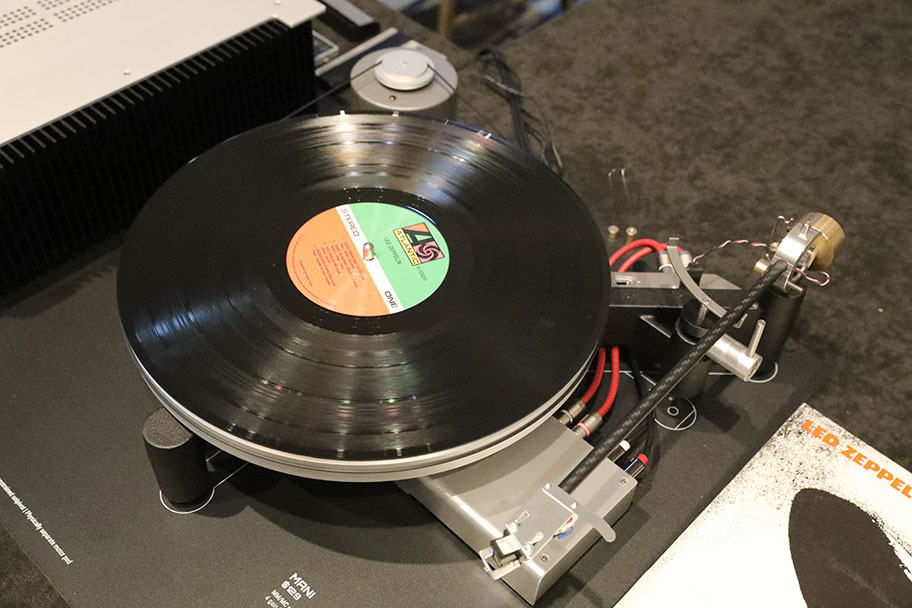
Phono stage preamplifiers are standalone analog devices which boost the electromagnetic signals received by the record player’s cartridge to a line level output signal, as necessary for reaching a power amplifier’s input stage. Phono stage preamps require their circuitry to be highly versatile, as they are often tasked with amplifying ultra-low signal levels delivered by cartridges of different design type (MM/MC, which we’ll explain below). These cartridges in turn deliver vastly varying signal gain and impedance results. High-end phono stage units offer extensive control over parameters such as capacitance, impedance and gain, which can prove especially beneficial in setups dealing with large music catalogs covering different eras, vinyl specifications and requiring different cartridges. The more control you have, the better things will sound!
It is important to remember not to connect the output of a turntable with a built-in phono preamp (i.e. newer generation record players featuring line outs) to the input of an external phono stage. Similarly the output of a phono stage preamp is raised to a line level, so when connecting it to the next device in your system chain (i.e. A/V receiver, hi-fi preamp or amplification) the type of input it’s connected to must be line level as well - normally labelled either as Aux or Line In just don’t connect it to the Phono In of your A/V receiver! Once a vinyl ‘rig’ is fine-tuned, simply no CD or any other digital media playback can even come close, on account of audio depth, width, warmth, punch, transient detail and just the sheer musicality emanating from vinyl records. Vinyl enthusiasts trying to improve their audio first reach out for a real good cartridge - the easiest ‘mod’ which delivers an immediate and often tremendous difference in sound quality. Getting the silent-as-a-whisper signal of the cartridge optimized to a healthy level needed by an amp’s input stage is one of the biggest challenges for achieving that coveted sublime vinyl playback. and this is why you need a great phono stage.
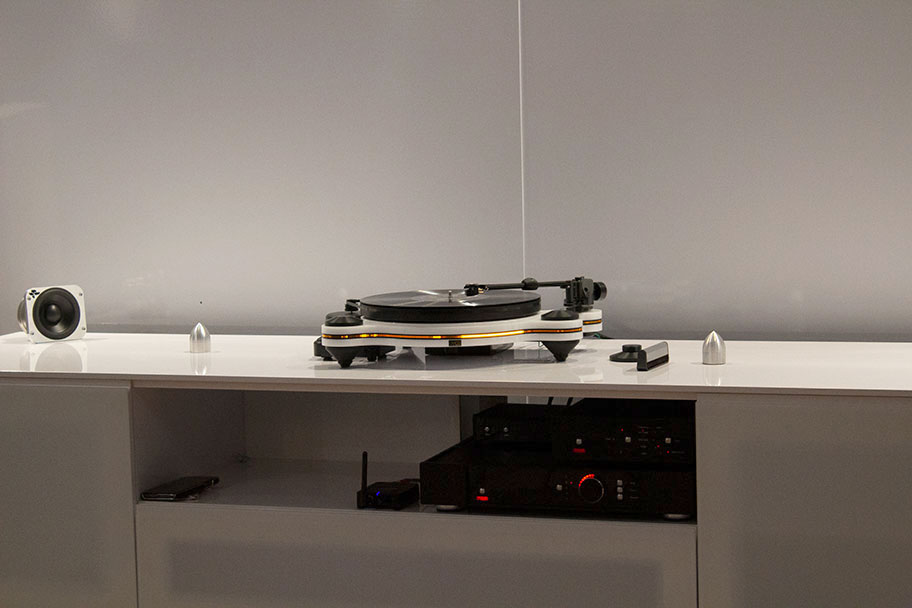
The key thing to understand when buying a phono preamp is this: it is not the same as a regular preamp. Amp manufacturers haven’t exactly gone out of their way to make this clear, so it’s the source of a lot of confusion. Let’s clear it up, and make sure that you’re buying the right product.
Every audio system needs a preamplifier. A preamplifier controls the volume, and makes sure that the input audio is routed to the right output. It works together with a power amplifier, which boosts the audio signal to levels we can actually hear. While it’s entirely possible to have a separate preamplifier box and a separate power amplifier box in your hi-fi system, most people opt for what is known as an integrated amplifier, or stereo amplifier. This is a single-box system that combines both preamp and power amp into one handy package. But here’s something a regular preamp can’t do: amplify audio from vinyl. That’s because the audio coming from your turntable is a very particular kind of signal, known as a phono signal (more on this below). This signal needs specialized circuitry to amplify it to acceptable levels, and turn it into what is known as a line signal, which can be sent to the rest of the system. You’ll find that specialized circuitry in a dedicated phono preamplifier (although some stereo amps come with phono preamps built in as well, which is very helpful). And it’s worth noting: while most companies in the industry use the term phono preamp, as we have here, you will also see them referred to by another name: phono stage. This is exactly the same thing as a phono preamp.
We’ve already discussed the differences between phono preamps and regular preamps, but it’s worth diving into the two types of signals they deal with. Namely: phono signal, and line signal. Understanding what these are, and how they work, will really help you get a strong sense of what your system needs to take it over the top. An audio signal coming out of the turntable is a very fragile thing. Think about it: it’s a translation of grooves in a wax disc, read by a very tiny needle, and then transmitted through a moving tonearm. This signal is known as a phono signal (from the word phonograph). It has two important properties. First, it’s really, really quiet—virtually inaudible. Second, because of how the cartridge records the grooves in the final, a phono signal boosts the bass and cuts the treble dramatically, resulting in audio that doesn’t actually sound very good all. You quite simply won’t be able to put a phono signal through most hi-fi systems as it stands—work needs to be done on it first.
This is where phono preamps come in. They do two major things to the phono signal: raising the volume and equalizing it. It is this second part that is most important. The equalization that takes place essentially ‘standardizes’ the signal, flattening its frequencies so that it can be read and understood by equipment further along in your hi-fi system. The end result is what is known as a line signal. It’s around 50-1,500 times stronger than a phono signal (depending on the preamp) and will be relatively flat in terms of bass and treble frequencies. If you have a turntable, you need a phono preamp to convert this final signal into line signal. You can’t get away with not having one, whether it’s a separate box, or included in your stereo amp.
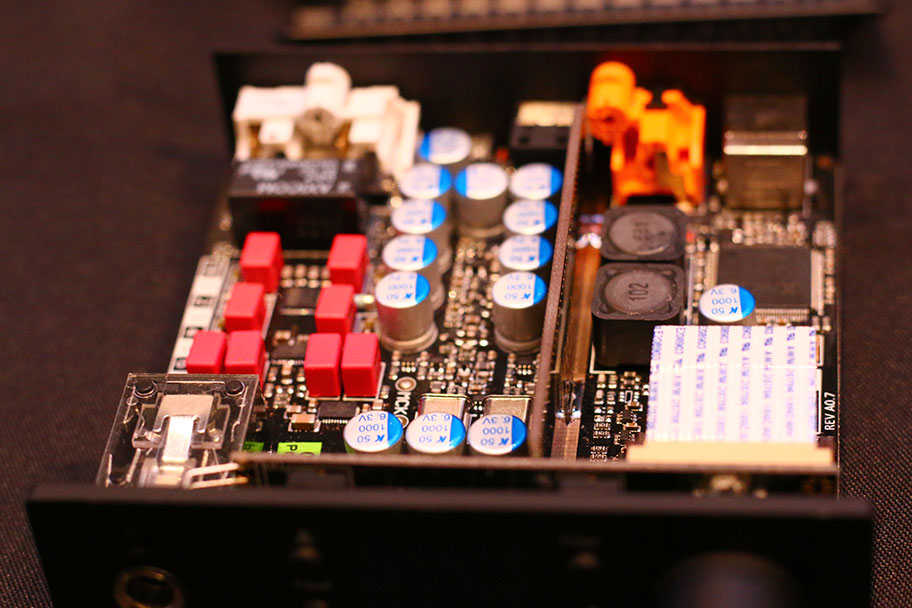
We’ve already mentioned that record cartridges are broadly divided by two types - moving magnet (MM) and moving coil (MC). Choosing one over the other often depends on your taste and record collection, as each type has its own sound (as well as its pros and cons) and each is arguably suited for specific purposes. To outline their differences, let’s start with the stylus (needle) first. When tracking the record groove, the stylus moves vertically as well as horizontally, and these movements are picked and converted to electromagnetic signals and sent through the wire in the tone arm directly to the phono stage preamp. This audio signal has an ultra-low level and is generated by a magnet and/or a coil - not unlike a very primitive microphone. Every phono cartridge features both a magnet and a coil, but they can have a different placement and function in regards to the stylus and this is where cartridge types differ.
Moving Magnet (MM) cartridges are the most common type and are hugely popular with ‘ordinary’ vinyl setups - their high output is well suited to the phono stage preamps found in traditional hi-fi preamps and AV processors. They feature two magnets (one for each stereo channel) at the end of the stylus. If their high output is the big plus, the weight of the magnets is the disadvantage, as it reduces the ‘agility’ of the stylus - tracking is therefore a bit less precise, which of course affects transient detail.
Moving Coil cartridges (MC) are pretty much the reverse of MM carts - instead of two magnets they feature two coils. These smaller and lighter components result in a much more accurate tracking and greater punch detail (transient attack). Unfortunately, moving coils generate a smaller electromagnetic current than magnets, and that’s a huge disadvantage when compared to MM cartridges. Despite their great sonic detail, the output delivered by MC type carts is so low that they are often unusable with generic hifi phono preamps. This is where a dedicated phono stage preamp well-equipped for MC signals is most needed and this combo (MC cartridge and phono stage) is arguably the first serious step towards an audiophile-grade vinyl setup. Unlike MM cartridges which generally feature replaceable styli, MC carts feature integrated needles, which cannot be replaced - when damaged or worn out you’d need to purchase a new one. While most phono preamps offer both MM and MC functionality, it's not uncommon for a high-end piece of gear to be MC only - as you can probably tell from the name.
You may also come across an MI cartridge, which stands for moving iron, this is a variation of the moving magnet type at present, although some vinyl specialist insist that it deserves it own category. Speaking of variations, another one exists - HOMC, which stands for high output moving coil - self explanatory, really. But honestly: MM and MC are the ones you will more likely than not have to worry about.
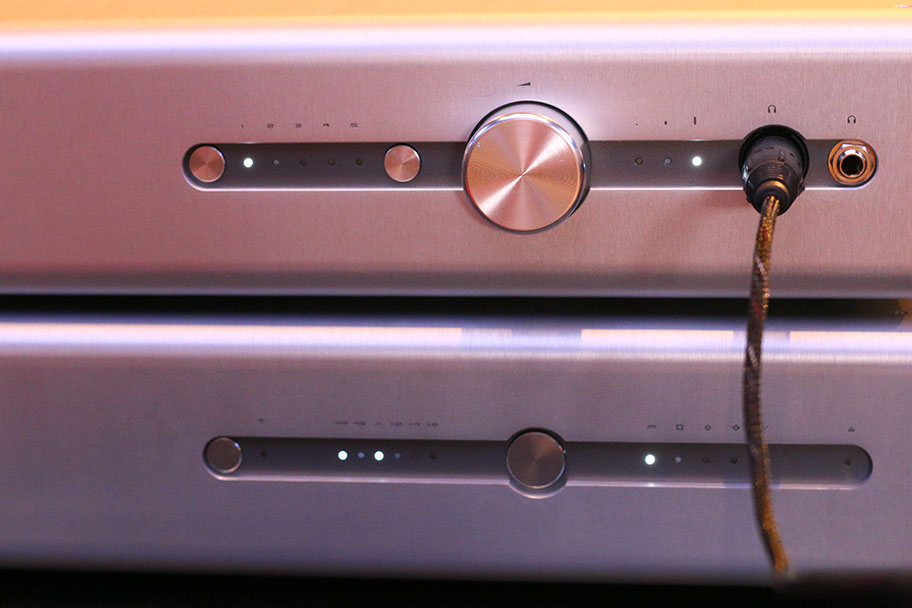
Phono preamps don’t actually need volume controls. That’s because their job is simply to raise a phono signal to an acceptable line level—something that is best accomplished without any human interference. Can’t have us ignorant humans fiddling with the volume control and ruining the audio fidelity now, can we? And yet, if you look at our list above, you will see at least one preamp that does have a volume control (the Cambridge Audio Alva Duo, our top pick). What gives?
The simple answer is that if a phono preamp has a volume control, it’s doing something separate to the actual signal conversion process. In the case of the Alva mentioned above, it’s controlling the volume of the headphone amp output. You occasionally will find other preamps that have volume controls, and they too are using them to control something separate from the phono conversion process.This Graham Slee Accession preamp, for example, has a volume control to help with its digital conversion stage. This is useful for those who are digitizing vinyl.
Here’s the bottom line: you don’t need to worry about controlling the volume with a phono preamp. That can come later, at the actual preamp or power amp stage. Your phono preamp should be as plug-and-play as possible—it’s designed so that once you’ve dialed in your preferred settings, you can more or less forget about it.
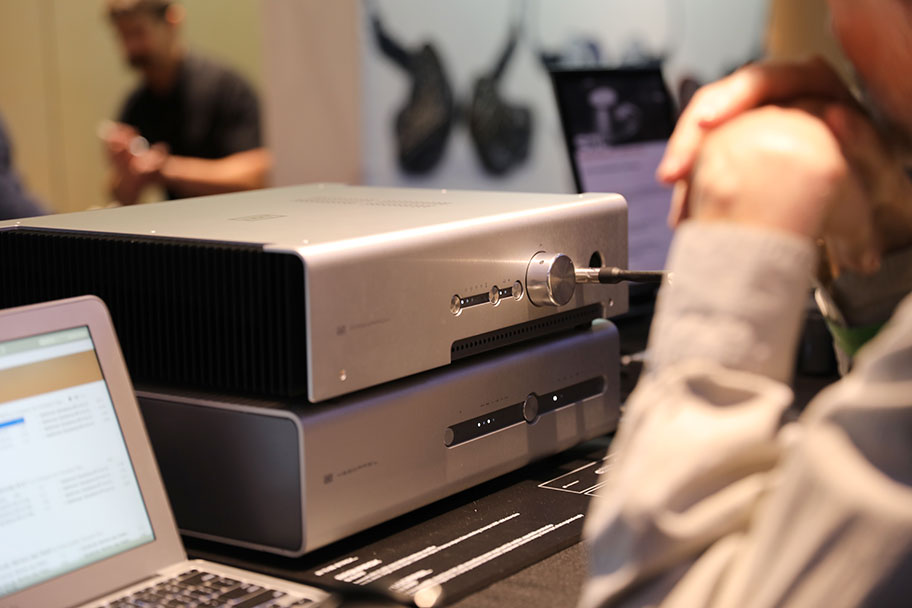
The above explainer on circuit components hopefully lifts the lid on the subject of why vinyl records and cartridges from different eras of vinyl manufacturing may require a specific frequency response curve to portray the correct nuance and detail of the release. Many of the phono stage preamps on this list deploy one of several built-in switchable ‘classic equalization’ modes - just like the RIAA example mentioned, but let us immediately note that their function is quite unlike regular EQs, as found in A/V receivers and/or integrated hi-fi preamps.
In a sense, these modes are very subtle - the passive circuitry simply ‘corrects’ the cartridge signal’s frequency response (and to an extent its signal-to-noise ratio) to match and mimic that of certain LP releases and specific decades from the historic vinyl manufacturing. Think of them as a filter that mimics the sound of a certain era. There are several universally recognized signature EQ curves - those associated with Decca, RIAA, Columbia, eRIAA, IEC, and eRIAA/IEC. If you happen to be using a cartridge with a vintage Decca spec (output, capacitance, impedance), just flip the switch/dial on your phono preamp accordingly - this will be as close as it gets to hearing the music ‘as it was intended’, certainly giving that old spinner an unexpected ‘remastered’ vibe.
Cartridge impedances vary from model to model, and to get the best possible audio quality, these values also need to be matched in a specific way at the phono preamp inputs. The vinyl gospel for impedance matching of MC cartridges (the most problematic, due to their extremely low output) is that the impedance value setting of the preamp needs to be roughly 2.5 times higher than the cartridge impedance value.
If, for example, you happen to be using a classic Denon DL103 MC cartridge which has an impedance value of 40 Ohms, the close-to-ideal preamp impedance setting would have to be 100 Ohms. In order to dial in such minute but important settings, audiophiles of the past decades have had to use additional ‘step up’ impedance transformers - just so that the phono stage preamp can receive the correct load, before in turn boosting it to line level. SUPs (step up transformers) are still around, but many of the finest current phono stages now take care of any impedance matching - either with a ‘continuous’ impedance dial or via switches.
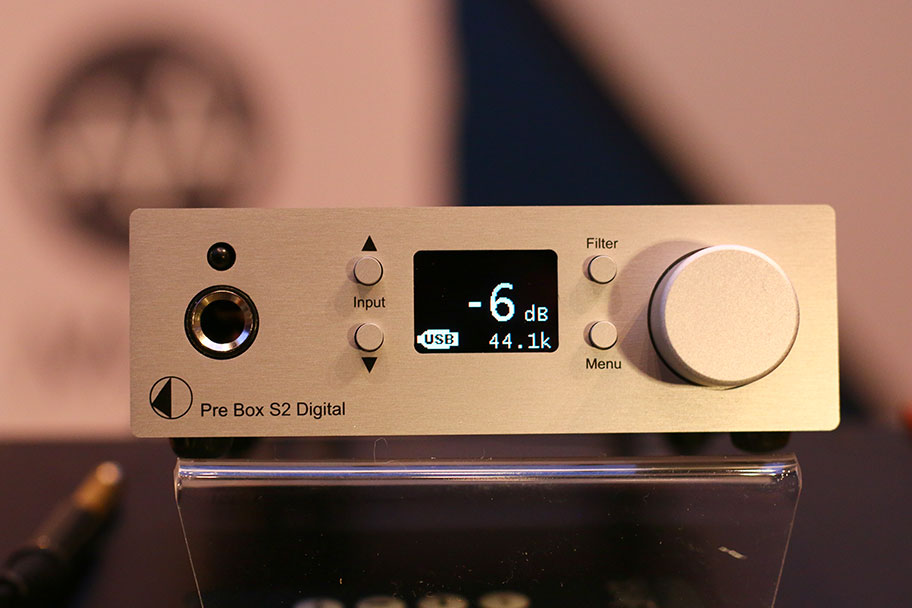
If you’ve ever had the time or inclination to hang out on vinyl audiophile forums online, you may have encountered posts of people trying to build their own phono stage preamps. Sure, many designs are simple, if you have a knack for that kind of thing - plenty of schematics can be found online. You can now easily buy any boutique component - from op amps and precious metal film caps to complete DIY preamp kits. Perhaps the best way to understand what makes phono preamps tick is looking into some of the original designs dating many decades back - like the RIAA Stereo Compensated schematic, since its circuitry is still considered a timeless classic. Let’s start with that word - compensated, as it really hits the bullseye from a design perspective and also in explaining why we need phono preamps in the first place. When manufacturing a record, grooves are cut into the vinyl, and the cut of different frequencies varies in width - high frequencies have narrower width than bass frequencies. Historically speaking, this presented an unexpected manufacturing problem, since the narrower grooves of treble frequencies were getting ‘lost’ in the record’s noise floor. To counter this effect manufacturers (well, mastering engineers, actually) had to artificially boost the highs in order to literally enlarge their grooves and lift those high registers above the noise threshold.
This is how the primary purpose of the phono-preamp (other than boosting gain) came about - to compensate for, or to tame, plainly speaking, the boosted tops (as well as sub-bass rumble frequencies) and bring them down to normal levels. The main circuit components achieving this filtering effect are called resistors. They act very much like sentries, only letting certain frequencies through. The cartridge signal passes through a 47K resistor, combined with a 100pF capacitor - these form the correct impedance of the cart while filtering out the nasty shrill boosted top end content above 30 kHz. On the other hand, the classic RIAA way of dealing with subby rumble is employing a 470Ω resistor with a 47uF capacitor. This is a simplified explainer on how a frequency response of a phono preamp circuit is built and needless to say, components with the same readings can come in a huge variety of quality as well as cost. Manufacturers of high-end phono stage preamps rely exclusively on their custom-made or boutique-grade component parts - the stuff that delivers the sweeter treble, cleaner bass and lower noise floor.
We already mentioned the intricate relationship between a record cartridge and the phono preamp. It’s a bit like how in the Batman movies a super small bat symbol (in this case the low level cartridge signal) is magnified by a huge spotlight (the preamp) resulting in Batman’s logo looming over the whole of Gotham city (alright, the metaphor here has to be a superhero-grade vinyl playback level). Indeed it’s all about optimum signal levels - starting at the source and moving along through every part of the signal chain.
How phono preamps manage sufficient gain figures, especially for LOMC (low output moving coil) carts is achieved in different ways and that depends on several factors. Firstly, it matters whether the circuit is solid state or vacuum tube - SS designs are considered easier to achieve high gain and low noise performance than tubes as a rule. Solid state phono stage designs rely on the op amp circuits (operational amplifiers) and resistors used. Just like DAC hardware chipsets are crucial for digital audio, op amps are important for the gain capacity and the overall musical character of a phono stage. In regards to tube circuits, yes, they can sound glorious but gain optimization in such circuits often require additional gain boosters such as transformers. They work great with MM cartridges, but not having enough gain, they may require a sidekick to help them manage those difficult low output MC cart signals.
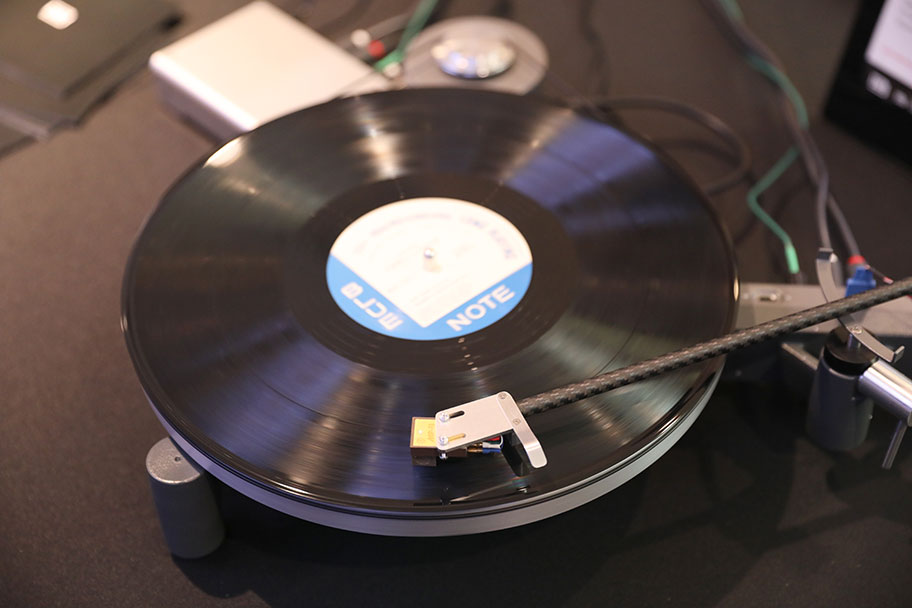
Capacitance is a term describing and measuring electromagnetic signal behaviour characteristics like load and resistance, which occur as the signal travels through cable wire, switches and so on. It is measured in picofarads (pF) and…OK, let’s stop right here with the lab jargon and explain why is this so important for cartridges (MC in particular) and phono preamps.
You will have seen by now that when talking of phono stage specs, we mention their ability (or not) to adjust capacitance values, in addition to signal impedance and gain (and all of that when going from the cartridge into the phono preamp). This feature (capacitance adjustment) is most needed with MC cartridges, which produce very low output signals. To deliver the correct frequencies to the phono stage preamp, different MC cartridges have specifically recommended pF values that the preamp needs to match.
This is where we need to note that poor quality (or simply too long) phono cables running between the record player and the phono preamp (as well as pots, switches, and so on) that the signal happens to pass through can increase the pF value of a MC cartridge.This increased pF value (or excessive capacitance) affects the cartridge's inductance. Even if we’re starting to get big jargon-y again, what you need to know is that this is something you can hear. Excessive capacitance makes an audible difference. Simply put, in such instances the sonic character of the record player changes because Incorrect loads act as unwanted filters or equalizers, introducing resonant peaks (a bit like those heard when scrolling through stations on an old fashioned AM radio) and these can ‘rob’ your audio of serious amounts of frequencies - mostly slashing the bell-like clear top end, and making the material sound ‘muffled’, ‘honky’ or ‘hollow’. The general rule is that high capacitance values reaching the inputs of phono stage preamps result in a darker and duller audio signature. Lower values (than recommended for the cartridge) would result in an overly-bright and distorted signal. The ability to adjust the pF value directly from the phono preamp effectively cures the problem. An example of the process of fine-tuning the cartridge vs preamp capacitance would again start with taking the cartridge’s pF value. Look, stick with us on this. It’s complex, but it’s important, and we think the following example should clear things up.
For instance, a contemporary star performer like the Soundsmith Zephyr cartridge has something like 100 - 200 pF value. A dedicated vinyl enthusiast would also have to take the capacitance specs of their tone arm (and its internal signal cable) - a worthy model such as the SME 309 Tonearm has capacitance values of 15.0 pF per channel. The sum of all of these pF figures needs to be matched at the preamp’s input capacitance settings (where available of course).
However ‘audiophile’ the circuit components may be, the phono preamplifier won’t do its job unless it has a top-notch power supply. Besides powering the system, there is a secondary role assigned to the PSU unit of a phono stage - one of a hum-destroyer. The noise picked up when amplifying such quiet signals as a cartridge feed is referred to as ‘mains pollution’. This percolates through the circuit, limiting the sonic benefits of high-end components. To minimize these mains pollution effects, manufacturers opt for high quality DC to DC converter chips, external high-voltage PSUs (Power Supply Units) which minimize interference and guarantee plenty of signal headroom. Vinyl connoisseurs can and do spend fortunes on power supplies and it doesn’t stop there - specialized power cables are also an important sonic factor as they affect the frequency response of the cartridge. Battery powered phono stages such as the Musical Surroundings Nova II are also popular with purists, as they solve mains pollution problems by completely removing mains-powered PSUs from their circuit.
Balanced and unbalanced connections are often referred to as pro and semi-pro respectively, and can at times have a dramatic effect to audio performance. Generally speaking, balanced connections on phono preamps are rare and are normally found in the high end market examples (mostly as a three-pin XLR outputs). Are they important? Very much so. To avoid another massive tech jargon tangent let’s just say that balanced outputs offer an impedance balancing between the individual wires within the connected signal cable, resulting in a better transference of the audio signal - better in terms of signal to noise ratio. Balanced circuits may be indicated by a sign: +4dB, unbalanced ones, by: -10dB. In the real world, spaces with lots of wiring and/or light dimmers (commercial buildings, offices and the like) are notorious for causing ground loops and hums to audio equipment. These are the cases where balanced outputs can come handy and act as effective hum-destroyers.